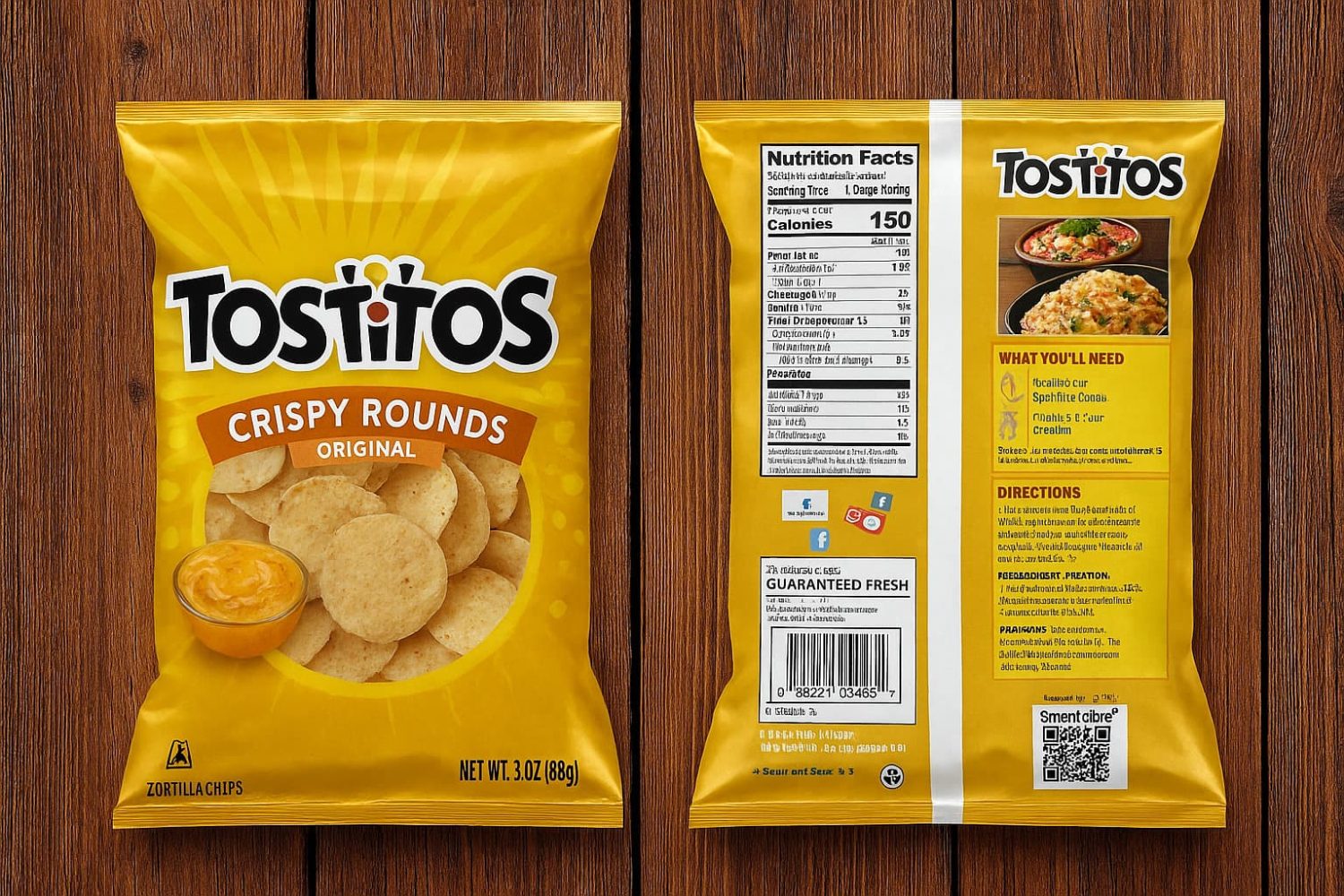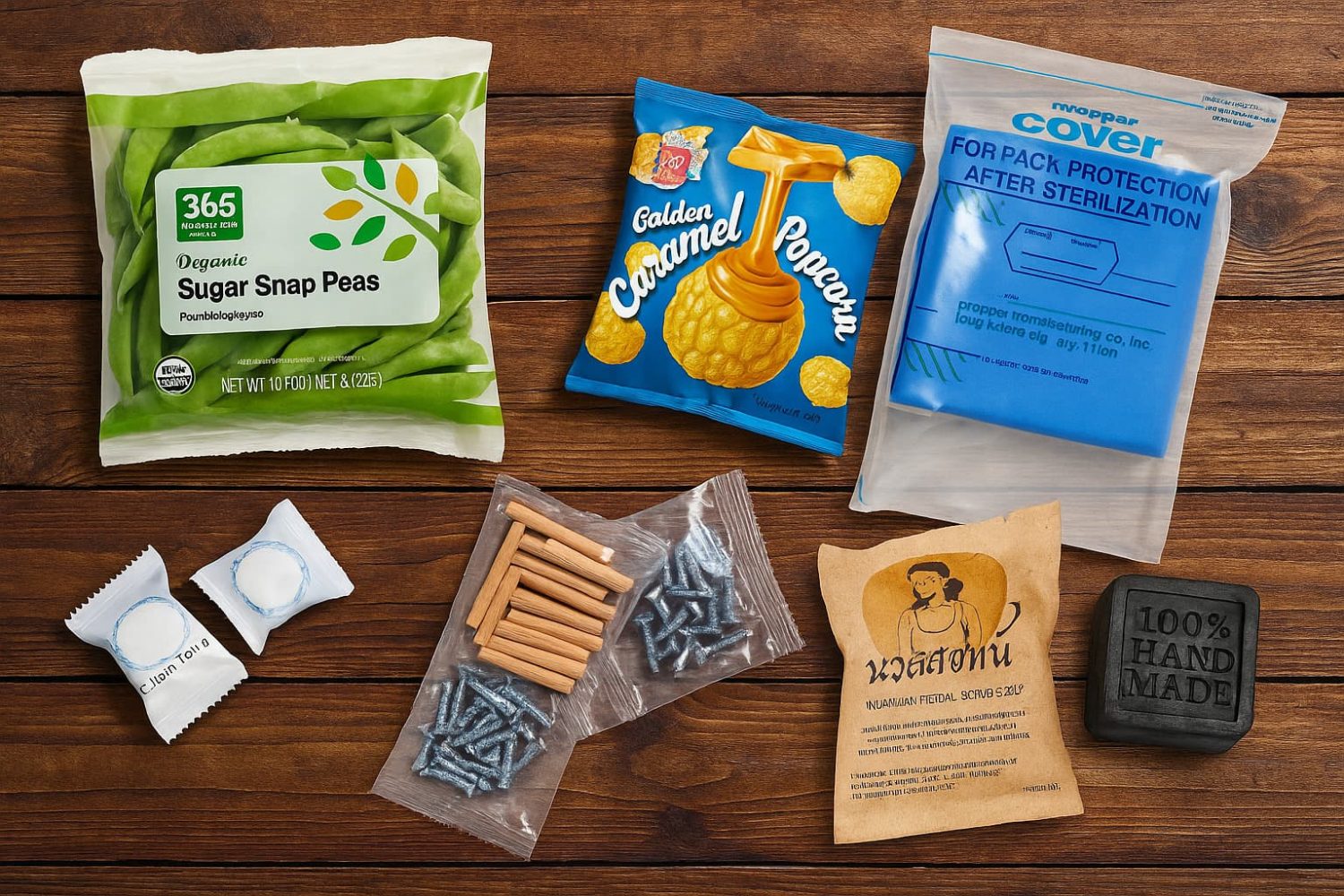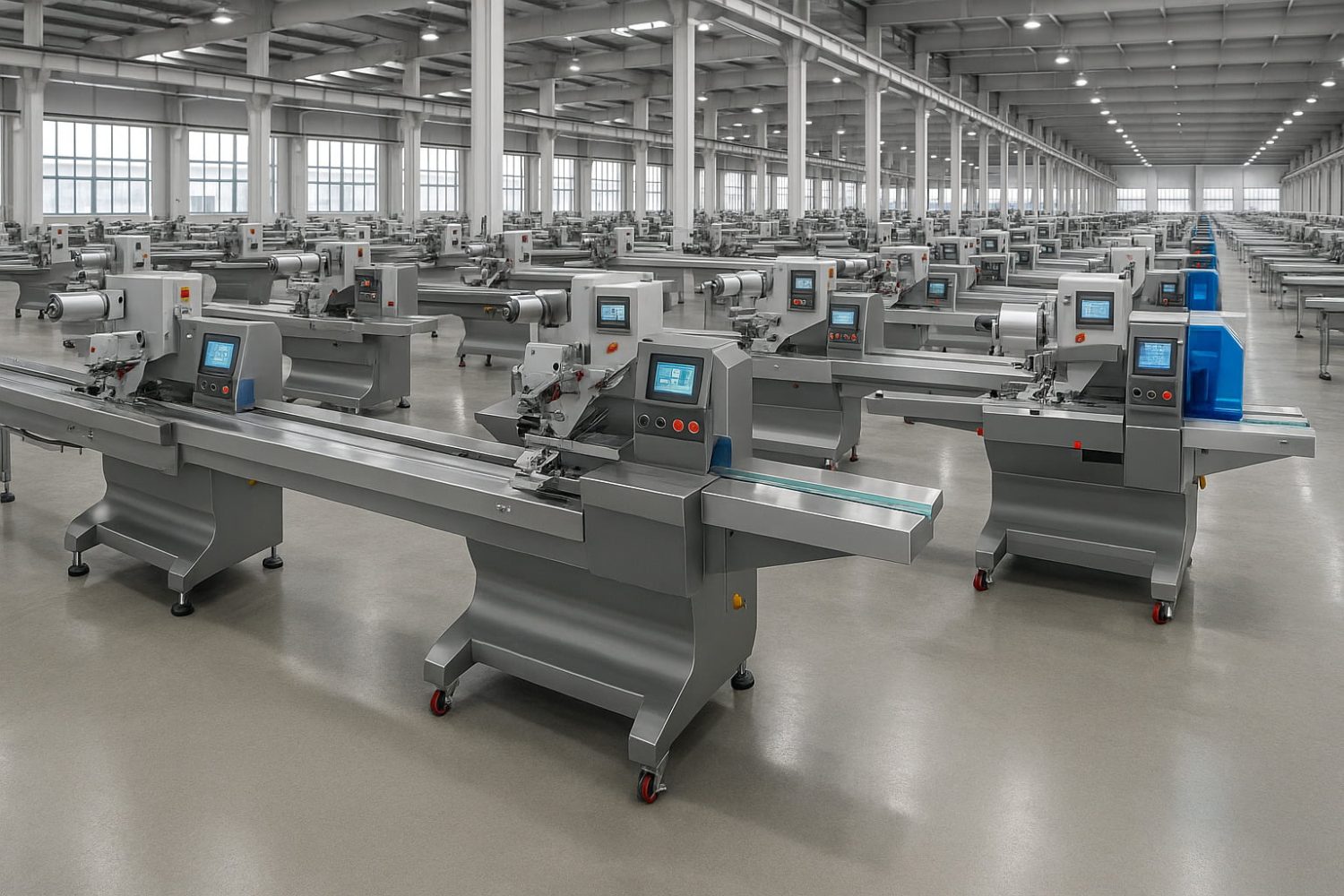More and more companies are looking for faster, more efficient ways to package their products. And one machine that’s catching their attention is the pillow packing machine. As the name suggests, this kind of machine creates those familiar pillow-shaped bags you often see for snacks or other products.
If you’re thinking about getting a pillow bag packaging machine this year, we’re here to help. Keep reading and you’ll get everything you should know before purchasing: what exactly pillow type packaging is, the types of machines available, key features to consider, how much the machine might cost you, and how to find a reliable supplier.
What Is Pillow Packaging?
Okay, let’s be clear. We’re not talking about packing actual pillows. Pillow packaging is a popular style of flexible bag that looks like a pillow. These packages have a seal at each end and a seam along the back, creating a simple rectangular bag that holds your product securely.

Benefits of pillow bag packaging include:
- Efficient use of material: It uses minimal film to enclose the product, which can lower packaging costs.
- Versatility: Pillow packs work for many different products, from snacks to screws, because the format is so adaptable.
- Compact shape: The finished packs are easy to stack, ship, and display on store shelves.
- High-speed production: Machines can form and fill pillow bags very quickly, making it ideal for mass production.
Types of Pillow Packing Machines
When it comes to creating pillow-style packs, there are two main types of pillow packing machines to choose from: horizontal and vertical.
The best choice depends on your product and how you need to package it. Not sure which type you need? Let’s break down each one and look at how they work and what they’re good for.
Horizontal Pillow Packing Machines
Horizontal pillow packing machines are often called horizontal flow wrappers. Products move sideways along a conveyor belt and get wrapped in film as they go. That’s essentially how a horizontal pillow packing machine works.
The machine forms a tube of packaging film around each item and seals the film along the bottom to create a back seam. Then, it seals and cuts the ends to make individual pillow packs. This continuous process can package many items per minute.
Typical Applications:
Horizontal machines are great for solid, individual items that can be laid on a conveyor.
Common examples include chocolate bars, granola bars, biscuits, pastries, and even non-food items like soap bars or medical devices.
Each item is wrapped snugly in its own pillow pouch, perfect for single-serving products or items that need to stay clean.
Advantages:
- Fast and efficient for wrapping individual items continuously.
- Gentle on products (items are carried on a belt rather than dropped).
- Ideal for products that need to maintain a certain orientation or alignment in the package (for example, a snack bar with toppings facing up).
- Can often integrate printers or labelers for date codes on each pack during the flow-wrapping process.
Limitations:
- Not suitable for loose, granular products or liquids.
- Take up more floor space in length due to the conveyor system.
- Changing product sizes may require adjustments or different tooling.
- Require your product to be consistently shaped and spaced for smooth operation.
Vertical Pillow Packing Machines
A vertical pillow packing machine is basically a type of VFFS (vertical form-fill-seal) machine. They work a bit like those popcorn machines at the carnival—dropping product into bags from above—but in a fully automated way.
The machine rolls out the film, forms a tube around the product, and seals the back. It then seals the bottom, fills the bag from above, and seals the top shut. You end up with a sealed pillow bag, and then the machine moves on to make the next one using the same film roll.
Typical Applications:
Vertical machines excel at packaging free-flowing or granulated products. If you want to package potato chips, candies, nuts, coffee beans, rice, or powdered products, they’re the way to go.
These machines are commonly used for packing food, pharmaceutical, nutraceutical products, and any item that can be poured into a bag.
Advantages:
- Great for high-speed packaging of powdered or granular products.
- Can work with multi-head weigher attachments for more accurate dosing.
- Have a small footprint, using floor space efficiently.
- Can handle a range of bag sizes by simply adjusting the length of film cut and swapping out the forming tube for different widths.
- Easy to integrate with scales, augers, or counters for automatic filling of precise amounts.
Limitations:
- Not ideal for very fragile products or large single items.
- Require additional equipment like weighers or feeders, which adds to the system cost and complexity.
- Taller machine height might be a concern if you have low ceilings or limited vertical space in your facility.
- Product changeovers can require cleaning out the product path to avoid mixing, which takes some time.
Key Features to Look for in a Pillow Bag Packaging Machine
When shopping for the right pillow packing machine, pay attention to several key features and specs to ensure it meets your needs:
Speed (Output Rate): How many packages per minute can the machine produce? Make sure the machine’s speed aligns with your production targets. For example, a small operation might be fine with 30 packs/min, while a larger factory may need 100+ packs/min.
Level of Automation: Some machines are fully automatic. You just feed in material, and they do the rest. Others might require a person to stand by or do necessary adjustments. Higher automation often means less labor needed, but also consider if you want features like automatic product feeding, sensors to detect jams, and so on.
Material Compatibility: Check what packaging films the machine can use. Most pillow pack machines handle common materials like polypropylene or laminated films. If you plan to use special materials (e.g., recyclable or biodegradable films), ensure the machine can seal them properly. Material thickness matters too. The machine should accommodate the film gauge you need for your product’s protection.
Footprint and Size: Consider the physical dimensions of the machine. A horizontal pillow packing machine tends to be longer. A vertical machine will be taller. Make sure you have enough floor space or ceiling height in your production area. Also, consider the machine’s weight if your floor has weight limits or if you need it to be mobile.
Ease of Maintenance: Look for a design that is easy to clean and maintain. If you’re packaging food products, make sure your machine is made from stainless steel. The material is hygienic and super simple to wash down. Plus, quick-change parts make maintenance faster and easier.
User-Friendly Controls: Modern machines often come with touchscreen interfaces and PLC controls. An intuitive interface means your operators can learn the machine quickly. Features like recipe storage and easy fault diagnostics are big pluses.
Versatility: If you need one machine to pack different products or sizes, check how versatile it is. Some pillow packing machines can adjust to various bag lengths, widths, or even handle different product types with interchangeable parts. A versatile machine can save you from buying separate equipment down the line.
Safety Features: Don’t overlook safety. Good machines have emergency stop buttons, safety guards, and sensors that stop the machine if something goes wrong. This ensures that both the machine and the user stay safe.
Common Uses of Pillow Packing Machines
Pillow bag packing machines are used across many different industries. Here are some of the main sectors and examples of how they apply this packaging style:

Food & Snacks: The food industry is the top user of pillow packs. Snacks like chips, pretzels, and candies are commonly packed in pillow bags to keep them fresh. Bakery items and confectionery also use pillow packaging for individual portions.
Pharmaceuticals & Medical Supplies: Some medical devices and pharma products use pillow packs for protection and hygiene. For example, a syringe or a bandage might be packaged in a pillow pouch to keep it sterile. Liquid medications, topical treatments, and protein powders are other examples where pillow-style packs are used.
Personal Care & Cosmetics: Single-use products like shampoo sachets, face mask packets, or soap bars can be packaged in pillow pouches. It’s a convenient way to distribute samples or travel-size products. While many cosmetic samples use flat sachets, pillow packs are also used for items that need a bit more room or cushioning.
Hardware & Electronics: Small hardware items are often sold in pillow bags with a label. It keeps the pieces together and is cheaper than boxing them. Similarly, cables, adapters, earbuds, and other small electronics accessories sometimes come in simple pillow-style plastic bags, especially when sold online or as spare parts.
Other Industries: Almost any small-to-medium item that needs a sealed pouch can use pillow type packaging. From pet treats to agricultural seeds, if they fit in a pouch and need protection, a pillow packing machine can probably package them. The versatility of these machines makes them popular in many niche industries.
Pillow Packing Machine Price in 2025
How much should you budget for a pillow packing machine in 2025? It depends on the machine’s capabilities, brand, and build quality. Here’s a general overview of price ranges (in USD) for new machines:
| Category | Typical Price Range (USD) | What You Get |
| Budget Machines | ~$5,000 – $15,000 | Basic models with lower speeds or semi-automatic operation.Great for startups or small businesses with modest production needs.Handle standard tasks but may have fewer features and require more manual oversight. |
| Mid-Range Machines | ~$15,000 – $50,000 | Good balance of speed and features.Often come from reputable manufacturers and offer solid automation, better build quality, and support.Ideal for mid-sized companies ramping up production. |
| High-End Machines | $50,000 and up | Top-of-the-line systems with high-speed output and advanced features (such as integrated weighing systems, printers, and remote monitoring).Built for large-scale production and continuous operation, often used by major manufacturers. |
Note: The above ranges are approximate. Also, remember to factor in shipping, installation, and training costs when setting your budget.
Where to Buy a Pillow Packing Machine
Now that you know what to look for, where can you actually buy a pillow packing machine? You have several options for sourcing, each with its own advantages:

1. Direct from Manufacturers
Most companies today have their own websites that often include online chat features. This allows you to talk directly with the vendor. It’s great if you already know the brand or model you want. Most manufacturers also help with setup and give some basic training. Always check the company’s reputation. Request a video demo or live walkthrough if you can.
2. Online Marketplaces
Sites like Alibaba or other B2B marketplaces have lots of options. They’re great for quick price and feature comparisons. You might find a good deal, but be careful. Check reviews, supplier ratings, and ask questions. Be careful with deals that look way too cheap.
3. Authorized Distributors/Dealers
Many brands have official dealers in different countries. Buying from them can make things easier. They often help you pick the right machine and handle setup and tech support. The price might be a bit higher, but you get better service and faster help if something goes wrong. You might also get to see a demo machine in person.
4.Used Equipment Suppliers
If you’re on a budget, used machines can save money. Some dealers and websites sell second-hand equipment. You might get a top-tier machine at a lower price. But check the condition, age, and if the brand still supports that model. If you can, inspect the machine or ask an expert to do it. Also, ask about its maintenance history.
Tips for Buying:
No matter where you buy, do some research. Look for reviews, testimonials, or case studies. Ask about the warranty and what kind of support they include. Free training or tech help is a big plus. Ask for references from past buyers. And make sure you understand all costs—like tariff, shipping, setup, and after-sales service—before you buy.
Final Word
Choosing the right pillow packing machine is a big decision, but it doesn’t have to be overwhelming. With the knowledge in our guide, you’re now equipped to make a smart choice. Remember to take your time, compare options, and ask plenty of questions before you buy. Here’s to finding the perfect pillow pack solution!